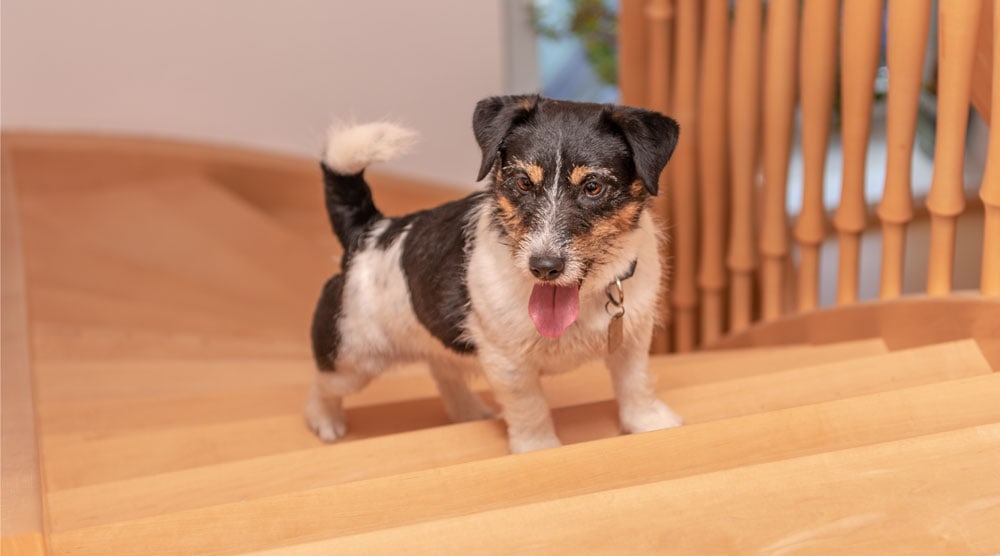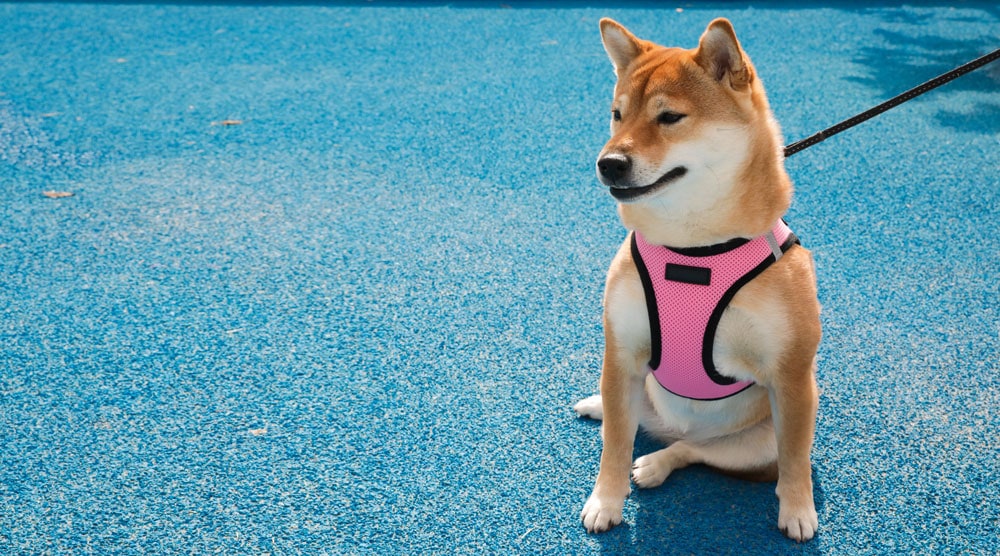It’s not unusual for adult dogs to worry about staircases if they didn’t use them as a puppy – especially if they were brought up in a single-story house.
However, a sudden reluctance to walk up a staircase can be caused by a medical or behavioural issue. Some potential reasons include the dog being in pain, fearful due to a traumatic event, or struggling with the effects of ageing.
Let’s take a closer look at why a dog might become afraid to walk up a staircase. We’ll also give you a step-by-step guide to overcoming a fear of stairs using positive training methods.
Contents
Health Reasons Why A Dog Might Suddenly Stop Going Up Stairs

Whenever you notice a behaviour change in your dog, the first step should be to take them for a vet checkup.
Pain, ageing, vision loss, and other medical problems can all cause your dog to become more anxious and cautious, which might affect their confidence on stairs. These potential issues need to be ruled out before you start behavioural training.
Pain
Pain is one of the most common reasons a dog might stop climbing stairs. Staircases put extra strain on the joints and muscles, aggravating the dog’s pain and making them not want to go upstairs.
There are many potential causes of pain in dogs, but osteoarthritis is one of the most common. It’s thought to affect over 80% of dogs that are older than eight, although it can develop in dogs of any age.
Conditions such as hip dysplasia, rheumatoid arthritis, hormonal disease, and cancer can also cause chronic joint pain that might make stairs uncomfortable.
Aside from chronic conditions, dogs can also suffer from acute injuries, such as muscle strain or back injury. These can make it very difficult for the dog to walk up a staircase without being in pain.
Important: You should always take your dog for an immediate checkup if you notice signs of pain in your dog. These might include panting, limping, licking the affected area, whimpering, lip licking, and sleeping more.
Vision Loss
If your dog suffers from vision loss, stairs might seem daunting and more difficult to climb.
Vision loss is often related to ageing in dogs – but this isn’t always the case. Health conditions such as diabetes, bacterial infections, and high blood pressure can also cause a dog to go partially or fully blind.
Even if your dog can muster the courage to go up a flight of stairs, this probably isn’t safe if they have vision loss. You might want to block off the stairs with a gate when you can’t supervise.
Ageing Process
Just like humans, dogs go through many changes as they get older. Some of these can make stairs difficult or scary to climb, which could cause a sudden fear of going upstairs.
Some examples include:
- Joint pain often becomes worse as the dog ages. This can make it uncomfortable to go upstairs, particularly if the hips and rear legs are affected.
- Dogs lose muscle strength as they get older. Climbing the stairs might become difficult and tiring.
- Many older dogs also lose some of their balance. This can make climbing stairs with hardwood floors particularly difficult.
- As we mentioned earlier, vision loss is also more likely in senior dogs.
It might seem like an elderly dog has suddenly stopped going up staircases. However, the dog may have struggled with some (or all) of these issues for a while. It’s only when the problems progress to a point where they can’t manage stairs that they become noticeable.
Behavioral Reasons Why A Dog Might Suddenly Stop Going Up Stairs
If medical causes have been ruled out, the next step is to identify behavioural reasons why a dog might be unwilling to climb stairs.
Bad Experience (Such As Falling) Leading To Trauma
When something scary or traumatic happens to a dog, the memories can affect future behaviour. So, if your dog has had a bad experience on stairs, they might become scared of climbing staircases.
There are many reasons a dog could associate trauma with stairs. The most obvious is falling down the stairs, especially if the fall caused injury or pain.
Getting scared by a loud noise while on the stairs could also make a dog fearful, even if the stairs didn’t actually cause the noise. Being shouted at when going up or down the stairs could have a similar effect.
Keep in mind that it often only takes one traumatic experience for a dog to develop a phobia of stairs.
Worried About What Happens Next
If your dog has learned that going upstairs leads to something they don’t enjoy, they might become anxious about the stairs. In this case, it’s not the stairs causing the issue, but what the dog has associated with the stairs.
For example, a dog might not want to go upstairs if they know this often means being left alone, spending the night in a crate, or bath time.
Try to monitor when your dog is afraid to go up the stairs. Is it all the time? Or is it at certain times of the day? Look for patterns that might help you uncover what’s making your dog scared.
Sometimes dogs are fearful of climbing a specific staircase. This could be because of slippery hard floors, small steps, or clutter that’s become a tripping hazard.
While any dog could be frightened of a difficult staircase, it’s more likely in senior dogs with balance or vision issues.
Why Positive Reinforcement is Essential for Overcoming Fears
Positive reinforcement training is the best way to help your dog overcome their fear of stairs.
By creating new and positive associations with the stairs, using a process called counter-conditioning, the dog gradually learns that there is nothing to fear.
On the other hand, you should never force your dog to go up the stairs.
Assuming your pet doesn’t have a medical issue, they will already feel scared and anxious. Forcing them to climb the stairs, or getting frustrated and angry, will only make the problem worse in the future.
In the next section, we’ll show you how to use positive training and counter-conditioning to help your pet.
Related Article: Using Counter-Conditioning to Overcome a Fear of Harnesses
How to Help a Dog Overcome a Fear of Stairs
Before you start using counter-conditioning and positive training to help your dog go upstairs, it’s worth asking:
- Is it necessary for your dog to go upstairs? If your dog is happy to be downstairs, then training them to go upstairs might not be worth the time and effort.
- Is it safe for your dog to go upstairs? This is an important question if your dog is senior, has vision loss, or has other medical issues. These dogs may need supervision and assistance going up the stairs, such as with a specially made harness to support the back legs. It’s often a good idea to block the stairs with a baby gate when you can’t supervise.
If you’ve answered “yes” to both of these questions, the next step is to create positive associations with the stairs.
- Start by making the stairs as easy as possible to access. Remove any clutter and consider putting down a non-slip surface if you have wooden stairs (such as a fixed runner).
- Choose a time when your dog is relaxed. Don’t try to overcome a fear when the dog is overstimulated, such as after a walk or when you have guests.
- Sit on the first step and spend some relaxed time with your pet. Reward them with a treat when they come near to you, but don’t force them or put them on a leash.
- Once your dog is happy to be around the bottom of the staircase, sit on the second step and place some treats on the first. Allow the dog to find the treats in their own time, and praise them when they do so.
- Whenever you feel your dog is comfortable at a certain step, move one step further back and repeat the process.
- By the third or fourth step, the dog probably won’t be able to reach the treat without stepping on the first step. You may need to slow down progression if your dog is nervous about this, but be patient and don’t force it.
- As you move up the staircase to the point where your dog is climbing up more than one step, make sure that they are also comfortable going back down.
- Continue until your dog can happily go up and down the staircase.
This process can take weeks or even months. Counter-conditioning involves building new associations in the dog’s brain, so it can’t be rushed.
Keep the sessions short, positive, and slow. Try to stop before your dog becomes anxious or frustrated, as it’s important to end on a positive note.
If your dog doesn’t seem to be progressing, or they have a severe phobia of stairs, you should contact a behaviorist for a training plan.
Tip: Don’t use public stairs for training. There are too many distractions which can make your dog feel uncertain.
Summary
There are many reasons why a dog might suddenly be afraid to walk up stairs. These can be divided into two broad categories:
- Health reasons, such as joint pain, illness, vision loss, or the ageing process.
- Behavioral reasons, such as previous trauma or negative associations with the stairs.
You should always take your dog for a vet checkup to rule out medical problems. If your dog is healthy, then you can use the method above to re-teach them that stairs aren’t scary.
Do you have any questions about why a dog might suddenly be afraid to walk up a staircase? Please let us know in the comments below.

